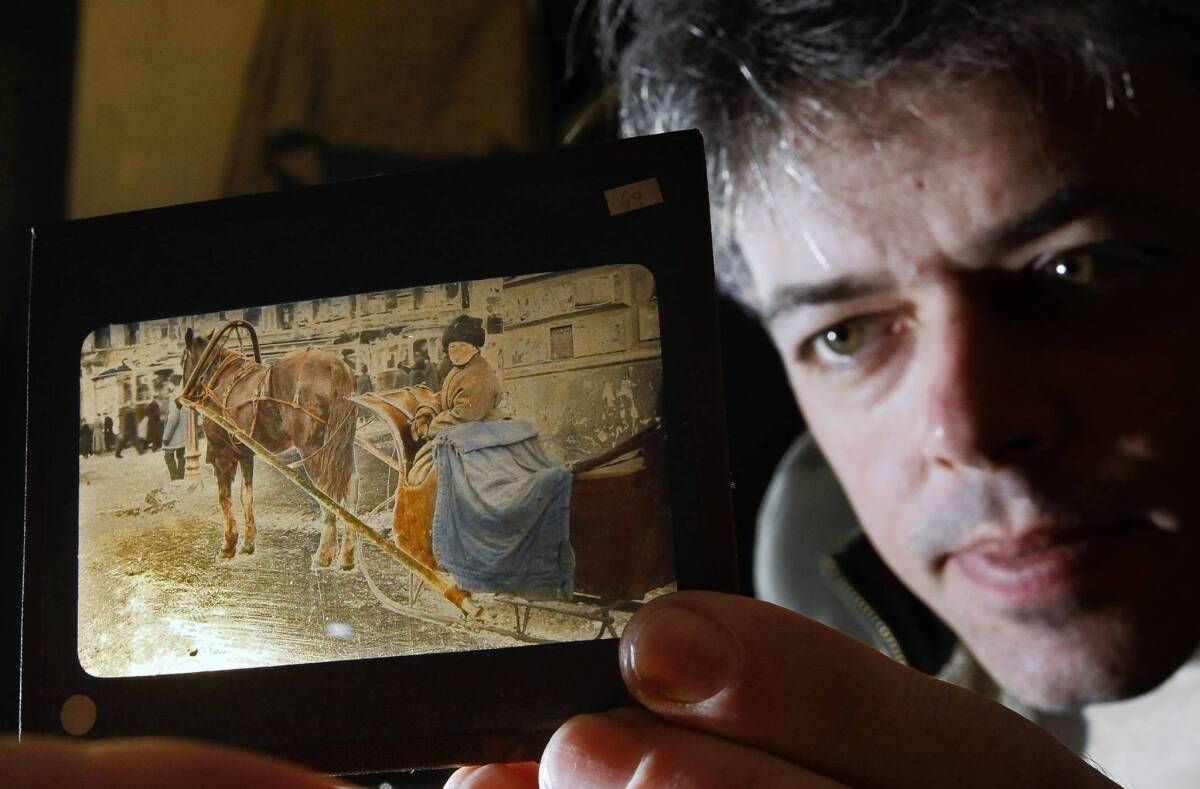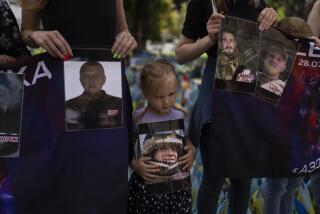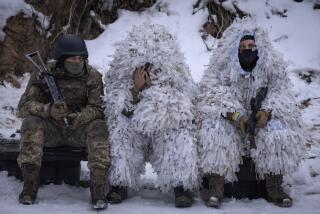‘Magic lantern’ images open window into Russia’s past

Anton Orlov held one of the glass plates to the light. The hand-colored image seemed to glow.
Two soldiers in long brown coats, rifles over their shoulders, stood with their backs to the camera. A trolley rushed out of the frame. A small patch of sky held a delicate blue wash, and red banners with yellow letters hung from the sides of a building.
Orlov swore he recognized the building. It had granite garlands above the windows and carved figures supporting the corbels beneath the balcony. He knew it from when he lived in Moscow.
PHOTOS: WWI-era Russia glass slides
He reached for another plate, then another. He read a few street signs, but most of the pictures showed a vast and treeless steppe with Cossacks and peasants bundled against the winter cold, snow and ice everywhere. He had never seen anything like them.
Barbara Hoffmann, who owned the plates, said her grandfather had taken the pictures. She hoped that Orlov — an émigré from Russia and a photographer as well — could tell her more about them. He had driven from his apartment in San Jose to her one-bedroom home off the back roads of Sonoma County near Sebastopol. His girlfriend, who knew Hoffmann, made the introductions.
The plates were stored in what looked like a shoe box. There were nine other boxes, Hoffmann said, more than 500 plates in all, each a little larger than a playing card.
The collection was probably valuable, but Orlov couldn’t tell its worth. More than the money, though, it was a well-composed document of a world that his family, three generations past, had once known, a world torn apart by war and revolution.
The more he saw, the more he became homesick. Orlov would never live in Russia again, but he would never forget when he did.
He didn’t have time to look at all the plates but wondered whether Hoffmann would consider selling them. That was eight years ago. He was 27 at the time, a photography student at San Jose State, and had caught an unexpected glimpse of his future.
Hoffmann was not quite ready to let them go.
::
She was only 15 when her grandfather, John Wells Rahill, had a fatal heart attack in 1966. There wasn’t much left of his life to hold onto: a dissertation from Yale, a sonnet that he wrote when she was born, a scrapbook, a brass samovar and this collection of photographs.
She felt embarrassed by how little she knew about him.
Rahill had been a pastor for the Central Congregational Church in Topeka, Kan. He was a slight man, and she thought of him as a Caspar Milquetoast. But she found it hard to reconcile that image with the man who took these pictures of war-torn Russia.
Her mother said he had been a secretary for the YMCA — Hoffmann imagined him in a typing pool — and just a few months after the birth of his only child during World War I, he left the family for the Eastern Front.
When Hoffmann was younger, she would look at the images and wonder who were these men in heavy coats or these children selling cigarettes in train stations.
Her mother promised to pull out the projector and properly show the pictures, but they never got around to it. As she developed Alzheimer’s disease, Hoffmann brought the collection home. By then, the story of her grandfather’s time in Russia was lost.
After their first visit, Orlov and Hoffmann kept in touch. She asked him to make some prints from the collection, and he offered to sort and catalog it. But he needed to take it home with him. Not quite strangers, not quite friends, she agreed, and a little more than a year after their first meeting, he loaded the boxes into his car.
He set up a light table in his living room, and using a zoom lens as a magnifying loupe, he studied each image. Before there were transparencies or slides — those pieces of celluloid shown on carousel projectors — companies could transfer images from black-and-white negatives to the special glass plates. The plates, known as “magic lantern” slides, would then be colored by hand.
Mixed with the plates were about 400 index cards upon which Rahill had typed a few words for each picture.
Russian Machine Gunner.
Dilapidated Building, Effect of Revolution, Fall of 1917.
Soldiers Tent Quarters. 50 degrees below zero at Valk.
Orlov paused over images of Rahill, distinguishable for his glasses, often in a bow tie and with a camera case hanging from his wrist. Orlov saw him standing on the brink of modern history.
War had erased the boundaries of Europe. The eastern front was in shambles: desertions, food shortages, labor strikes. The czar had just abdicated. A provisional government assumed power, and in October — just before Rahill’s arrival — the Bolsheviks stormed the Winter Palace, beginning the country’s long experiment in socialism.
Orlov paused over a shot that showed barricades crisscrossing the streets of Arbat Square in Moscow. Sixty years later, he was born in that neighborhood.
In another picture, a boy was selling newspapers at the train station in Omsk. Orlov’s great-grandparents were from that town.
::
After returning the collection to Hoffmann, Orlov still pursued Rahill’s life. He prowled the Internet, called the YMCA archive in Minnesota, contacted churches in the Midwest.
He learned that Rahill couldn’t join the Army because he was clergy. He enlisted instead with the National War Work Council of the YMCA as a secretary, someone who provided services to soldiers fighting the Germans.
In 1917, he crossed the Pacific and made the long journey to Valk, a small town known today as Valga, on the border between Latvia and Estonia. He set up a chapel and recreation room in a school and welcomed soldiers on leave from the front.
Rahill’s Russian adventure ended when the Bolsheviks grew suspicious of foreigners, and after three months, he returned home. Orlov believes Rahill had the glass plates made in order to show images of war and of Russia to a wider audience.
One hundred years separated them, but Orlov felt a connection to Rahill. When he and his mother immigrated to Brooklyn in 1994, he too landed in an unfamiliar world.
He had just graduated from high school in Moscow and would have to enlist in the army, but neither he nor his mother wanted that. The military was not welcoming to Jews or Muscovites, and memories of the 1991 and 1993 attempted coups — tanks on CNN, explosions outside their window — were still vivid.
Orlov tried to capture their departure at the airport. But his camera broke, adding to the confusion of the moment — his estranged father waving goodbye, his girlfriend in tears, luggage ripping open — and at the last minute, they had to buy a new crate for their dog.
Orlov and his mother moved to San Diego when she landed a job with a pharmaceutical company. He took up surfing, enrolled at Palomar Community College and was going to be a biochemist until friends took him hitchhiking to Seattle.
On the trip, he decided to be a photographer. He earned a fine arts degree. He practiced black-and-white printmaking. He took portraits of friends at Rainbow Gatherings and made videos backed with punk music or instrumental hip-hop.
At 35, he lives in San Diego, rents darkroom space and plans to drive around the country in a school bus that he converted into a darkroom and art studio. In 2017, he hopes to visit Russia and re-photograph the buildings and locations on the glass plates.
::
Two years ago, Hoffmann agreed to sell the collection: $1,500 for everything, including the projector. The recession had hit her and her husband hard — she was a potter, he a woodworker — and she felt guilty for letting go of her grandfather’s legacy. The decision was easier when Orlov agreed to make a digital copy of the collection for her.
Last month, Hoffmann, 61, was surprised to hear from Orlov. He said he had developed a presentation of her grandfather’s slides. He called it “Orlov’s Magic Lantern Experience,” and he wanted to stop by.
Guests crowded a small studio on her property. Hoffmann hung up a large sheet of white fabric, and as Orlov worked the projector, she watched her grandfather’s world emerge from the darkness. Whether Orlov’s ambitions were eccentric or inspired, she couldn’t tell, but she admired his earnestness.
“If anyone has the will and the stamina and the youth and the interest and the skill to do anything with these pictures, it is he,” she said.
PHOTOS: WWI-era Russia glass plates
The pictures had allowed Orlov to capture his identity, and through his research, Hoffmann connected with her past.
After the presentation, he gave her two glass plates, featuring images of her grandfather in glasses and bow tie. The next day, Orlov was on the road in his school bus, heading north on 101. He had booked more showings farther up the coast.
More to Read
Sign up for Essential California
The most important California stories and recommendations in your inbox every morning.
You may occasionally receive promotional content from the Los Angeles Times.











